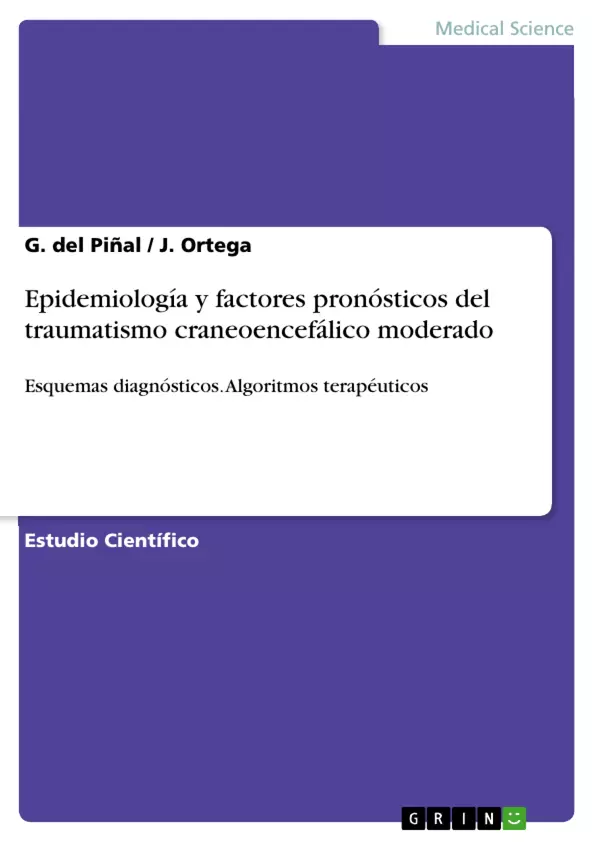El traumatismo craneoencefálico (TCE) es un fenómeno muy frecuente, asociado a elevadas tasas de morbilidad. Clásicamente se ha prestado más atención al traumatismo craneal grave, existiendo pocos estudios hoy en día que analicen el
traumatismo moderado. El objetivo de este estudio ha sido describir una serie amplia de pacientes adultos, mayores de 14 años, que sufren TCE moderado atendidos en el Hospital Universitario de Getafe, entre los años 2005 y 2015 (n = 66), estudiar el perfil epidemiológico de presentación, y analizar el diagnóstico y el tratamiento efectuados, así como establecer los principales factores pronósticos que influyen en el resultado final. Se ha realizado un estudio retrospectivo, de revisión de historias clínicas y entrevistas telefónicas. El TCE moderado es más frecuente en varones, y el mecanismo causante más común en nuestro medio es el accidente de tráfico. Se establece la necesidad de ingreso hospitalario, en planta de neurocirugía o en UCI, según la situación clínica y los hallazgos radiológicos. En este estudio, las variables que han resultado más determinantes de la evolución adversa en el paciente que sufre trauma craneal moderado son los hallazgos patológicos en la TC, la existencia de focalidad neurológica, la presencia de deterioro clínico, la edad avanzada, los hallazgos en la TC de control, y los atropellos, caídas e impactos directos como mecanismos causantes. La escala de Glasgow para el Coma es deficitaria en la determinación del resultado final del paciente que sufre TCE moderado, porque no considera la diferencia de pronóstico entre pacientes con
puntuación de 11 y 12, más parecidos al trauma leve, y los que obtienen 9 y 10 puntos, con un pronóstico más similar al del paciente que sufre trauma grave.
Inhaltsverzeichnis
- 1.- RESUMEN, ABSTRACT:
- 2.- INTRODUCCIÓN:
- 2.1.- Concepto de traumatismo craneal y consideraciones generales:
- 2.2.- Epidemiología del traumatismo craneal:
- 2.3.- Fisiopatología del traumatismo craneal:
- 2.4.- Diagnóstico y manejo clínico del traumatismo craneal:
- 2.5.- Factores pronósticos del traumatismo craneal:
- 2.6.- Evolución del traumatismo craneal:
- 3.- PLANTEAMIENTO Y OBJETIVOS:
- 4.- MATERIAL Y MÉTODOS:
- 4.1.- Criterios de inclusión y clasificación de pacientes:
- 4.2.- Diagnóstico y manejo clínico:
- 4.3.- Estudio estadístico de la muestra:
- 5.- RESULTADOS:
- 35.1.- Descripción de resultados obtenidos:
- 5.2.- Estudio estadístico:
- 6.- DISCUSIÓN:
Zielsetzung und Themenschwerpunkte
Die vorliegende Arbeit untersucht das moderate Schädel-Hirn-Trauma (SHT) bei Erwachsenen über 14 Jahren. Ziel ist es, eine umfassende Beschreibung einer großen Patientengruppe, die zwischen 2005 und 2015 im Universitätsklinikum Getafe behandelt wurden, zu liefern. Die Arbeit beleuchtet epidemiologische Aspekte, diagnostische und therapeutische Vorgehensweisen sowie wichtige prognostische Faktoren, die den Behandlungserfolg beeinflussen.
- Epidemiologie des moderaten Schädel-Hirn-Traumas
- Diagnose und Behandlung des moderaten Schädel-Hirn-Traumas
- Prognostische Faktoren im Zusammenhang mit dem moderaten Schädel-Hirn-Trauma
- Analyse der Wirksamkeit verschiedener diagnostischer und therapeutischer Maßnahmen
- Bewertung der Glasgow-Koma-Skala in Bezug auf den Verlauf des moderaten Schädel-Hirn-Traumas
Zusammenfassung der Kapitel
- 2.- INTRODUCCIÓN: Dieser Abschnitt bietet einen allgemeinen Überblick über das Schädel-Hirn-Trauma und seine Bedeutung im klinischen Kontext. Er beleuchtet die Definition des Schädel-Hirn-Traumas, seine Epidemiologie, Fisiopatologie, sowie die gängigen diagnostischen und therapeutischen Verfahren.
- 3.- PLANTEAMIENTO Y OBJETIVOS: Dieser Abschnitt beschreibt die Forschungsfrage und die spezifischen Ziele der vorliegenden Arbeit.
- 4.- MATERIAL Y MÉTODOS: In diesem Kapitel werden die Methoden der Datenerhebung und -analyse erläutert, einschließlich der Auswahlkriterien für die Patientengruppe, des Datensatzes und der statistischen Verfahren.
- 5.- RESULTADOS: Dieses Kapitel präsentiert die Ergebnisse der Studie, sowohl in deskriptiver Form als auch in Form von statistischen Analysen.
Schlüsselwörter
Schädel-Hirn-Trauma, moderates Trauma, Epidemiologie, Diagnose, Behandlung, Prognose, Glasgow-Koma-Skala, Krankenhausaufenthalt, neurologische Ausfälle, radiologische Befunde, statistische Analyse, Patientengruppe, Krankenhaus Getafe.
- Citar trabajo
- G. del Piñal (Autor), J. Ortega (Autor), 2018, Epidemiología y factores pronósticos del traumatismo craneoencefálico moderado, Múnich, GRIN Verlag, https://www.grin.com/document/414280



